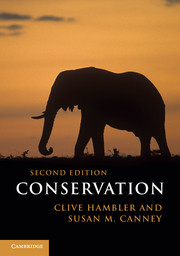Book contents
- Frontmatter
- Contents
- Preface to the Second Edition
- 1 Introduction to conservation
- 2 Threats to biodiversity
- 3 Evaluation of priorities for species and habitats
- 4 Monitoring and Environmental Impact Assessment
- 5 Management of natural and fragmented habitats
- 6 Management of species
- 7 Sustainable use, semi-natural cultural landscapes and the matrix
- 8 Restoration and offsetting
- 9 Environmental policy
- References
- Index to species names
- Index
- Plate section
6 - Management of species
Published online by Cambridge University Press: 05 February 2013
- Frontmatter
- Contents
- Preface to the Second Edition
- 1 Introduction to conservation
- 2 Threats to biodiversity
- 3 Evaluation of priorities for species and habitats
- 4 Monitoring and Environmental Impact Assessment
- 5 Management of natural and fragmented habitats
- 6 Management of species
- 7 Sustainable use, semi-natural cultural landscapes and the matrix
- 8 Restoration and offsetting
- 9 Environmental policy
- References
- Index to species names
- Index
- Plate section
Summary
Our limited resources preclude customised management for the majority of species. Indeed, most species and their requirements may never be known. Fortunately, the management of several individual species simultaneously can make a substantial contribution to management of habitats, and the management of keystone and umbrella species will be particularly important (Section 3.1.4). Conservation focused on species can be applied in the wild habitat of the organism (‘in situ conservation’) or in captivity (‘ex situ conservation’) or both. This chapter examines conservation of individual species and of groups of related species that can be treated together because they have similar requirements, threats or appeal. Issues relating to re-introduced and translocated species are also discussed in Chapter 8.
Many nations have species-specific conservation plans, often developed in response to national legislation and to satisfy requirements of the Convention on Biological Diversity. Examples include National Recovery Plans in Australia and the Endangered Species Act in the USA. Many of these plans aim to recover species to a favourable population status, with defined targets, monitoring and costing.
Experience with species recovering under the Endangered Species Act shows that an increasing number of species are becoming ‘conservation-reliant’ and will be dependent on long-term management after immediate threats have been overcome. Extrapolation suggests that this trend threatens to overwhelm some conservation budgets (Section 9.3.2). A further problem with the species-level approach is that management aims can be in conflict (Section 3.1.4). For example, the Everglades snail kite and the wood stork need different water levels. The recovery programme for the San Clemente loggerhead shrike involved removal of predators, causing a large decline in abundance of the San Clemente Island fox.
- Type
- Chapter
- Information
- Conservation , pp. 203 - 236Publisher: Cambridge University PressPrint publication year: 2013

